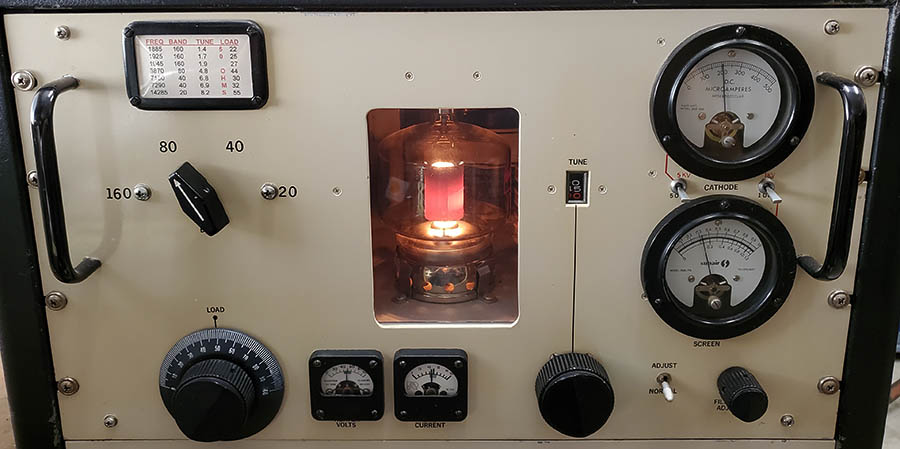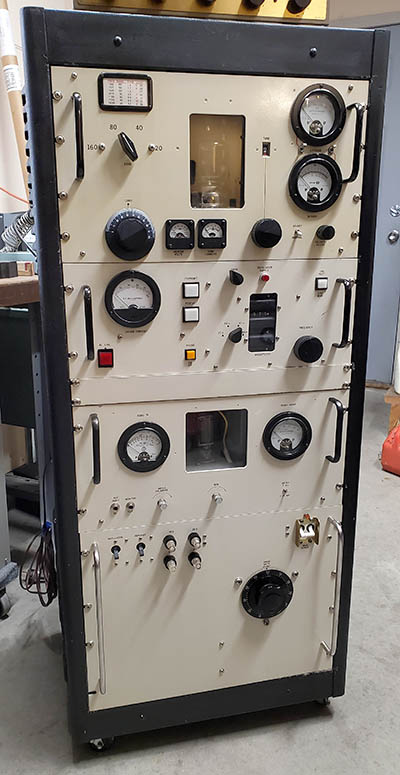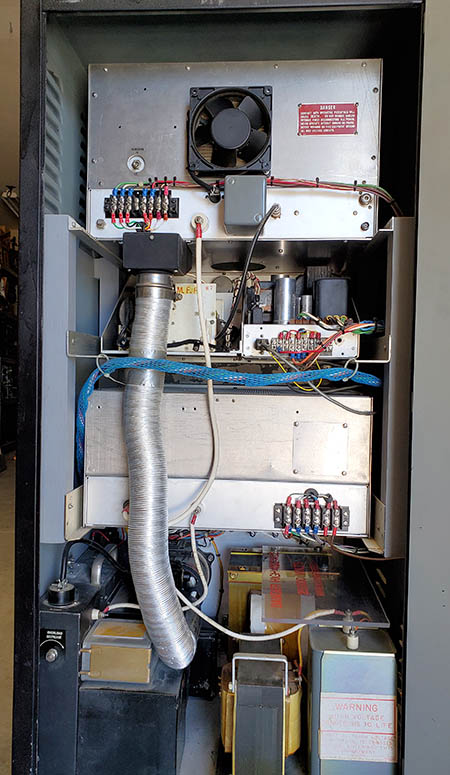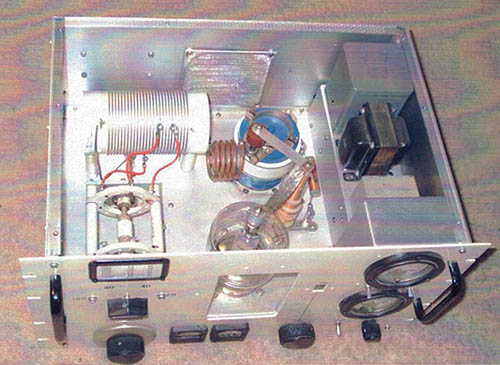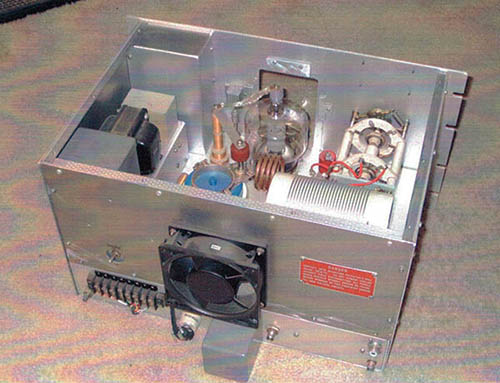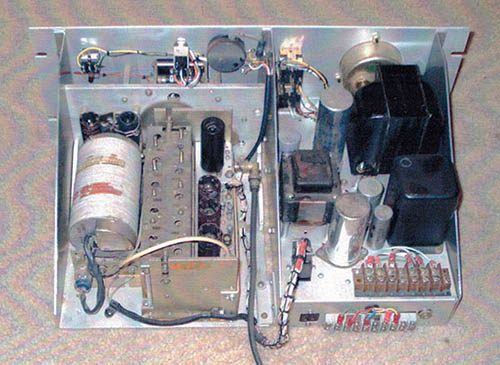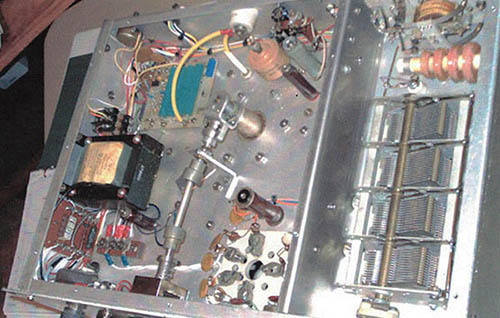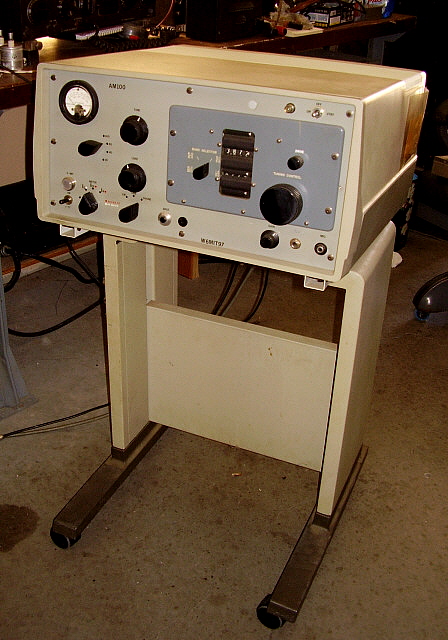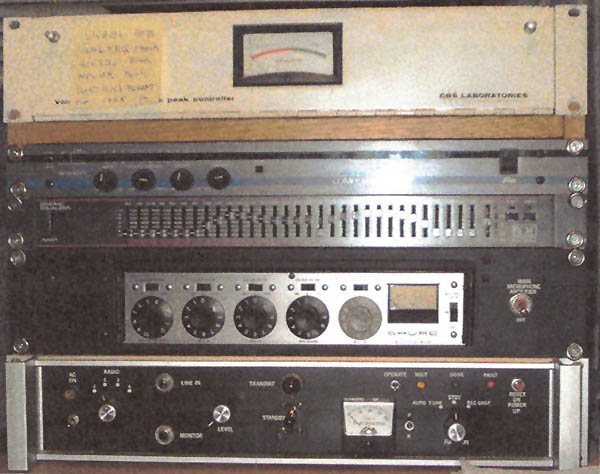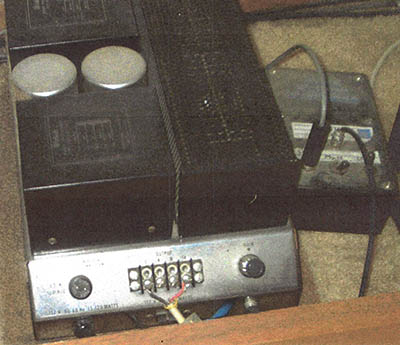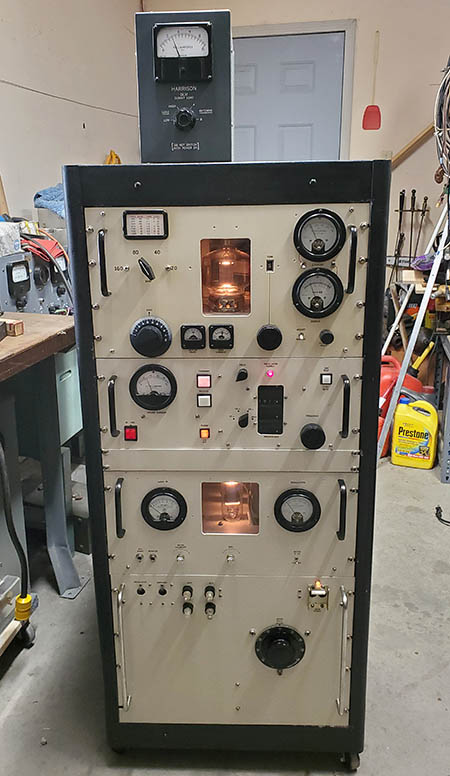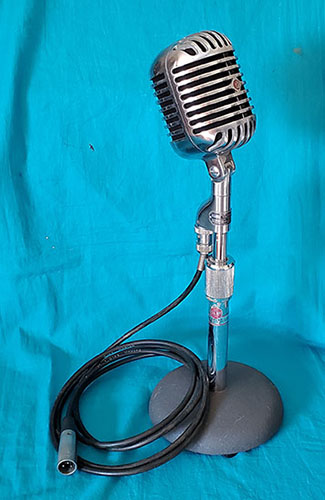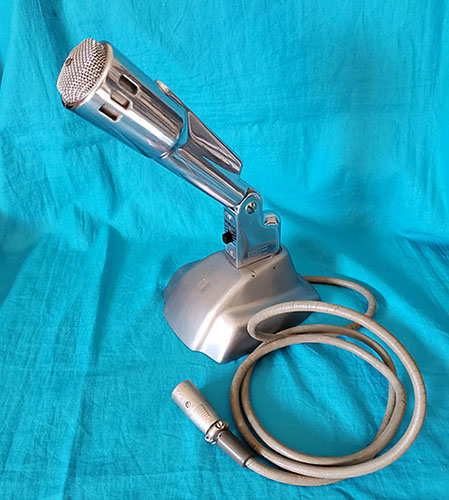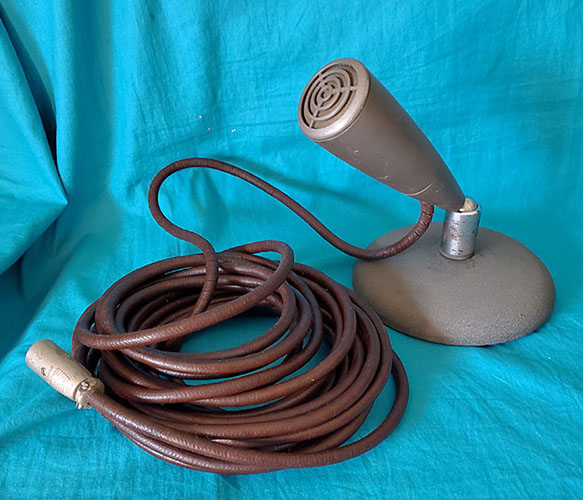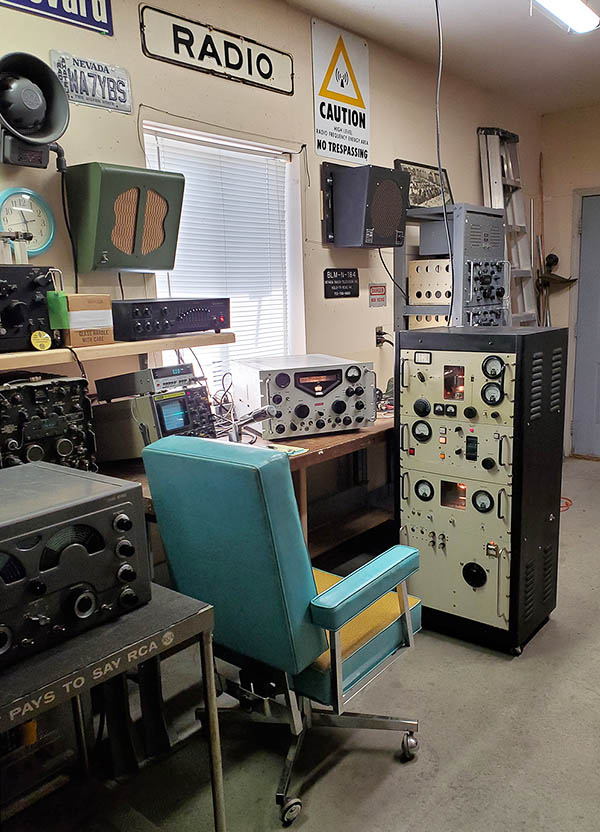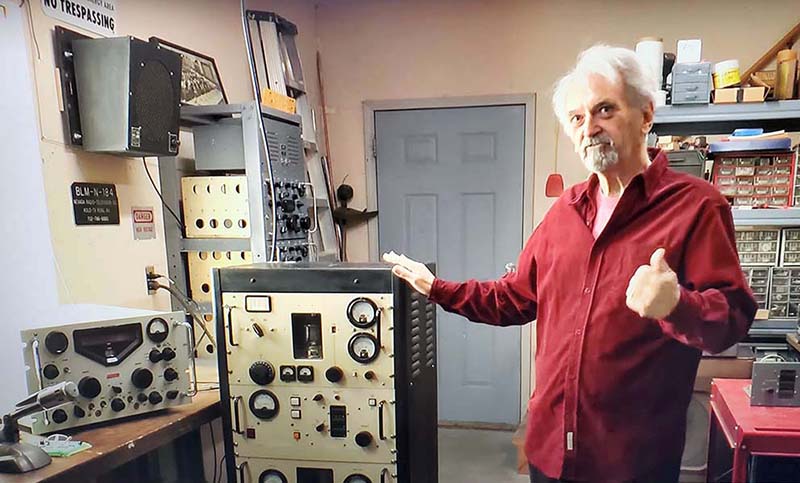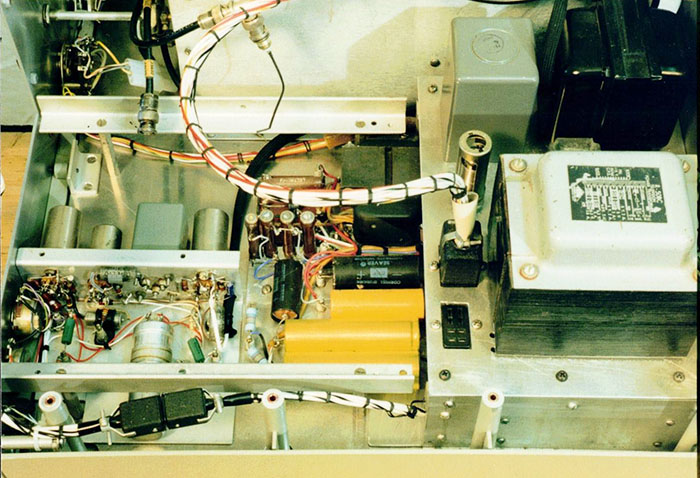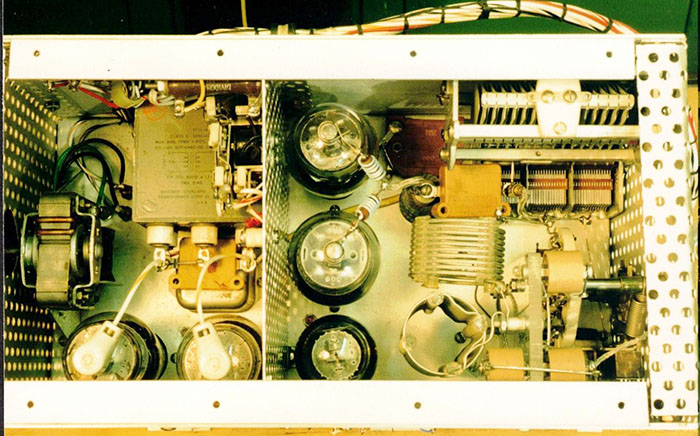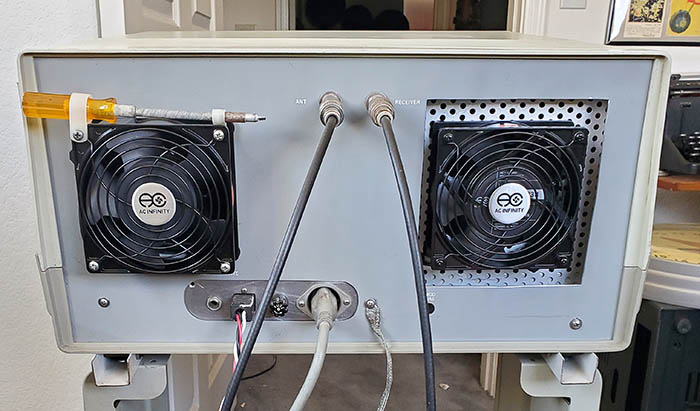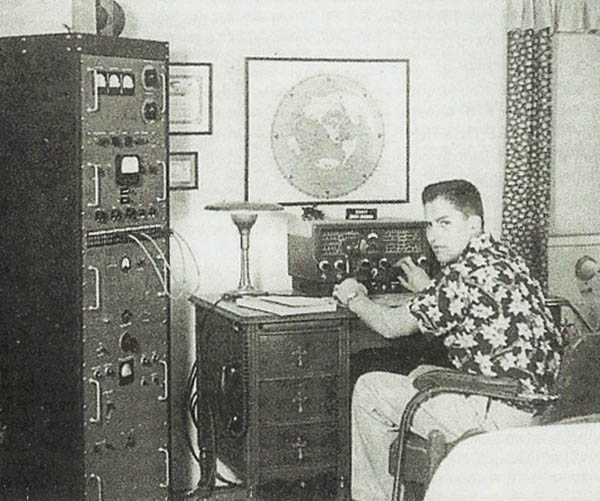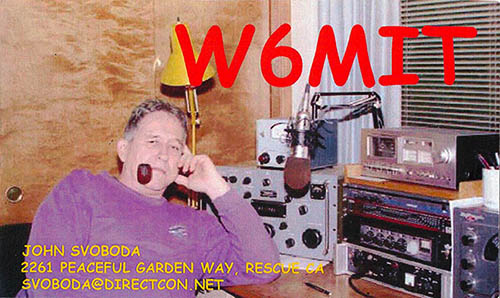"1625 Rig" Follow up Five
Years after Purchase - 2023
- For the past four years I've had the "1625 Rig" in the upstairs ham
shack. Most of that time it was operating using a 135' CF Tuned Inv-Vee
antenna. That antenna was destroyed in a winter storm at the end of
2022. For the past five months, the "1625 Rig" has been operating on the
75M Collinear Array antenna which should exhibit a slight bit of gain (about
+1.9db is possible.) The audio quality is instantly recognized
whenever I'm operating the "1625 Rig" and I only use a D-104 on a TUG-8
stand with a PL-68 plug as the audio input. At borderline QRP-level 70
watts of carrier power, as expected, conditions play an important part
in successful communications. Using the "1625 Rig" in the winter is
generally without any problems since propagation is excellent at that
time of the year. Summer conditions will
always present a challenge. It does depend a lot on the receiving
station's QTH and their local noise level. On my end, the receiving
noise level is about S-2 or less (I always hear everybody on the net,
regardless of the time of year.) But, using a 70W AM transmitter and
trying to have my skywave propagated signal overcome the receiving
station's local S-9+ noise level is difficult no matter what time of the
year it is or what type of antenna I use.
The Noisy Fan - One change I've
been wanting to make to the 1625 Rig is to replace the fan that is
mounted behind the PA/Modulator box with another type of fan that would
be quieter when running. This fan is extremely loud making the
transmitter sound something like a vacuum cleaner when it's in operation. The 1625 Rig has two fans but the
one for keeping the power transformer cool is a very quiet 120mm "muffin" fan.
The second cooling fan is the noisy one because of how and where it's
mounted along with a blade design that creates more noise than air flow.
In looking at how the PA/MOD fan mounts, the open frame motor is on the inside of the
PA/MOD box. Then the shaft protrudes though a purf-metal (.190" diameter
holes) rear panel and
the fan blade is mounted external to the purf-metal rear panel. The fan
is mounted so that it draws air from the front of the PA/MOD box then
through the box and exhausts hot air out back. The PA/MOD box has a purf-metal
front panel to allow air in. There is another purf-metal divider between
the PA and the MOD sections. Since there are three purf-metal panels,
maximizing air flow volume wasn't an issue and apparently a minimal air flow will keep the 1625
tubes cool (this is the only transmitter I've seen where the 1625 tubes
are actually "cooled.") I can use a "low noise" type of muffin fan to
replace the old external four blade fan. I'll have to remove the
transmitter rear panel and the rear sheet metal piece on the PA/MOD
chassis. I'll remove the motor mount that is on the chassis inside the
PA/MOD box and then the new muffin fan will mount to
the exterior of the rear panel of the PA/MOD box. I might enlarge the shaft hole in the
rear purf-metal panel to 4" for better fan performance and reduced noise (no purf-metal
directly behind the fan blades.) These fans can be mounted with rubber
bushings to reduce vibration. Usually the modern muffin fans are very
well balanced and don't produce any vibration. Just the opposite is true
of a open frame motor with a long shaft and removable fan blades.
Vibration is dependent on the
rotational dynamic balance of the rotor inside the motor and on the position of
the fan blade on the shaft (and normally the fan blades aren't
dynamically balanced either.) So, these open frame types of fans always seem to vibrate
excessively. The variables are all removed when using a muffin fan so
balance is always excellent and vibrations almost non-existent. The AC
Infinity Type 1238 runs at 1800RPM and moves 62cfm of air and has a
noise rating of 32db (just above a whisper.) The Type 1238 physically
the same size as the muffin fan installed to cool the power transformer
at 120mm.
If the Type 1238 is mounted to the rear panel of the transmitter there
will be a symmetrical appearance of the two fans that should look like
it was planned that way. Ordered the Type 1238 on August 7, 2023.
Clean Up - Aug 7, 2023 -
I removed the top cover and also the top cover on the PA/MOD box to
inspect the fan mounting. It looks like I'll have to pull the PA/MOD box
to do the actual fan removal and installation of the new fan. In looking
over the modules, I noticed how dusty everything was. I haven't had the
top cover off of the 1625 Rig since 2018 and looking at the photos I
took of the chassis then it doesn't look that dusty but I know all this dust
didn't accumulate in the past five years (well, maybe some of it.) At any rate, I'll have to
clean up everything while doing this fan upgrade. While I'm at it, I'll
test all of the tubes,....something I didn't do when I first got the
1625 Rig since it had come almost directly from W6MIT and he had been
using it regularly on the 40M AM net. So, this reworking will be the fan
upgrade plus a service and detailed cleaning.
Removed Exciter and Removed PA/MOD box
- Since the design is modular, removing these two modules was easy. The
Exciter was very dusty. Even the mechanical digital (Veeder-Root type)
readouts were dusty and the inside of the plexiglass window was dusty.
Detailed cleaning and lubrication required Exciter front panel removal. The band change mask
articulation was gummed up and sticking which required cleaning and lubrication.
Even then, I had to shorten the return spring about .375" to increase
the return tension to get the mask to change position without dragging
slowly. The plexiglass needed cleaning and the front panel also needed
cleaning and buffing to have it looking like a nice condition T-368
Exciter. Knobs needed cleaning, especially the flutes. Soaked in warm
soapy water for a half an hour then brushed to remove the finger gunk
from the flutes. I had to replace the band switch pointer knob because
of some sort of white deposits that wouldn't clean off. End result,...it's the best this Exciter has
looked in a while.
I removed the back purf-metal piece on the PA/MOD box. This allowed easy access to remove
the fan motor and mounting bracket. There are two insulated stand-offs
for 120vac to the fan, so the new fan power cord can connect there. I removed the
fan-mounting bracket since the muffin fan will be mounted directly on the rear purf-metal
panel. Cleaned inside the PA/MOD box. Light dirt is all. Cleaned up
nicely. I enlarged the shaft hole in the purf-metal rear cover to 4" to
allow unrestricted air flow out of the PA/MOD box.
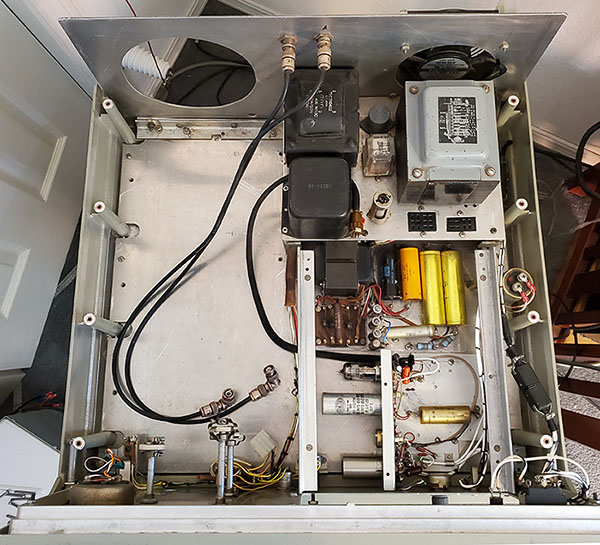 |
|
Photo Left - The 1625 Rig with PA/MOD box
removed (on the left) and the T-368 Exciter removed (on the right.)
Removal of the Exciter reveals the Speech Amplifier that's located
underneath. The front section of the power supply is also revealed when
the Exciter is removed. Note how W6MIT's 2007 upgrade leaves only two
tubes in the Speech Amp and also that most of the original components
were replaced (compare to W6MIT's 1997 photo above.) The chassis mounted
power supply transformers and chokes provide the +HV at +800vdc and the
screen voltage supply at +350vdc for the 1625 tubes. Additionally, the 12.6vac and 6.3vac
filament voltages and the -30vdc bias supply are supplied by the
transformer windings. Note that the two chokes on the left side of
chassis are much
larger than the pre-2007 chokes. The 0A2 regulator is for
the Exciter PTO.
Note that the T-368 Exciter sets on rails
in the transmitter and that allows easy removal of the unit. The PA/MOD
box mounts to the aluminum bottom plate and is entirely connected into
the circuit with wire cables/connectors or with coaxial cables for the
Ant output, the Receiver input and the Exciter output to PA input. Also,
note this photo shows the rear panel fan hole as circular. It was
modified to be a square opening for the new fan placement in 2023. |

The T-368
Exciter after clean-up. I had to replace the band switch
knob with a good condition original. The digital
display and masks required "front panel off" cleaning
and adjustment. |
|
Tube Testing Had Interesting Results
- I didn't test the tubes in the "1625 Rig" when I first got it since it
seemed to work as described in MIT-John's manual. So, after five years it's
about time that the tubes were tested. The results seem to confirm that
perhaps I should have tested the tubes sooner. I used my
old TV-7B for testing.
1625 - 4 tubes - I replaced three of the
four 1625 tubes. One modulator tube was weak (well below minimum
acceptable) and one PA tube was weak (also below min.) I selected replacements from my NOS stock that seemed to match up pretty well.
6Y6G - 1 tube - This tube tested strange
but I tested a few other NOS examples and they all do essentially the same thing.
That is a fast large upward swing of the meter, then a fast dropping
down to zero and then a slow rise to something above minimum acceptable. I
replaced the original 6Y6G because it didn't rise up to minimum. The
third tube tested (NOS ones) seemed to perform correctly rising well above
minimum, so it was
installed.
12AX7 - 1 tube - As expected this tube
tested very weak (way below minimum acceptable) on one triode and just
at minimum on the other triode. I installed a good 12AX7.
12BY7 - 1 tube - This tube tested very
weak, way below minimum. I installed a NOS 12BY7.
6AH6 - 3 tubes - Two of the
three tubes tested okay. I had to replace one as it tested at minimum acceptable.
5749/6BA6 - 2 tubes - PTO tubes tested
good.
5763 - 1 tube - Tested good
0A2 - 3 tubes - All three tested good
So, in total seven tubes were replaced out of the 16 tubes used in the
transmitter. The 1625 Rig did work and, other than complaints about my
lack of signal strength, none of the "on the air" contacts ever
mentioned anything else (maybe because of the "weak signal".) Most tube-based devices will seem to function okay with weak tubes. Really bad tubes,...that is, those that have open filaments, hard
shorts, etc., of course, those won't work. But, weak tubes will perform
okay,...but just okay,...not great. So, I'm not expecting a big change
and maybe not anything even noticeable. I just like to have a transmitter or receiver
equipped with all "tested-good" tubes installed. So, this might be the
first time that I'll experience using the 1625 Rig in that condition.
One of the first things noticed was the increase to 75 watts of AM
carrier output power with 150mA of pI.
New Fan Installation -
Due to the depth of the muffin fan at 1.5" thick, it can't be
mounted inside the PA/MOD box as there is only about .75" clearance from
the rear panel to one of the 1625 modulator tubes. Mounted on the
outside of the purf-metal rear panel only .75" of clearance was
available between the back of the PA/MOD box and the rear panel of the
transmitter unless the rear panel opening is modified. I think the mounting of the
fan to the rear of the PA/MOD box with a 4" diameter opening,
eliminating the purf-metal obstructions, will result in the best air
flow and cooling.
Testing the fan mounted to the purf-metal rear panel resulted in quiet
operation and lots of air being drawn through the box. I
removed the transmitter rear panel for measurements to modify the old
oval-shaped opening. I decided that if I went with a square opening, fitting
the PA/MOD box with the rear mounted fan into the transmitter would be
easier since there would be lots of clearance for positioning the box
with no interference with the rear panel opening. The square opening is
about .75" larger all around the square fan perimeter with the opening being about 6"
square. The easiest method to enlarge and
reshape the rear panel opening was to use a jig saw. Afterwards only
minor touch-up with a file was necessary to have the four sides square
(see photo below.)
As for power to the fan,
the fan itself has a plug-in cord with receptacle. The fan AC cord
was routed through a grommet-hole and soldered to the insulated
stand-offs that the original fan had used.
photo right: PA/MOD box showing the
modification for the new fan
mounting for reduced noise and improved air flow |
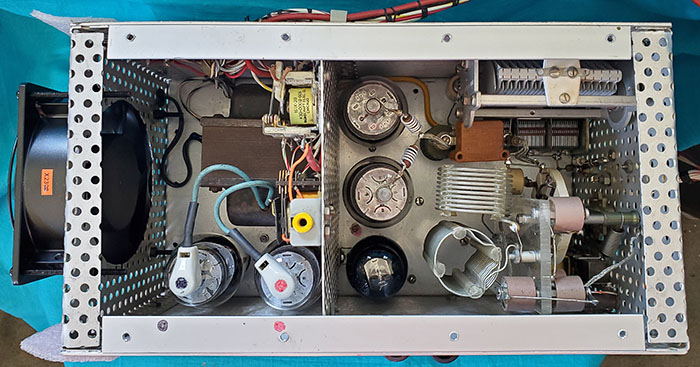 |
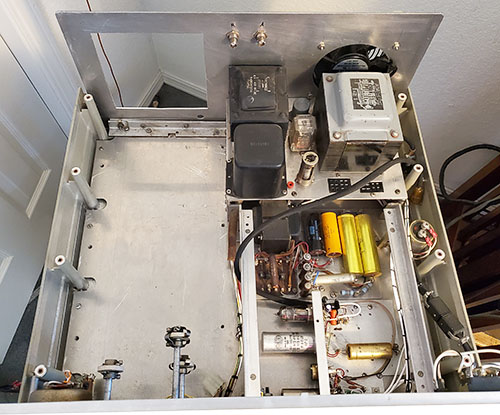 |
I think this arrangement will cool the 1625 tubes much better than
before. The original fan installation had the blades outside of the purf-metal
holes forcing the fan to draw the air entirely though .190" diameter purf holes located
in three separate panels. Now the fan mounting is
entirely open (as can be seen in the photo above) and pulls air just through the purf-holes in the front of
the box and through the divider purf-holes. To test the air flow, I used
a 2"x 2" piece of paper towel and with the fan in operation the piece of
paper towel was pulled on to and would "stick" to the purf-holes in the front of the PA/MOD
box. The transmitter cabinet air flow arrangement is the 120mm fan by the power
transformer pushes cool air into the transmitter cabinet then the PA/MOD box
120mm fan pulls that air through the box and exhausts the warmed air out
the back of the transmitter.
The final benefit is the fan noise has easily been cut in
half, maybe more. The combined fan noise was somewhat over 60db
before because you had to raise your voice to talk over it. The
noise is much less now but the new AC Infinity Type 1238 is so
quiet that the noise from the old Radio Shack fan that blows on
the transformer sounds relatively loud now. I unplugged the Radio Shack fan
and listened with just the Type 1238 on, very quiet indeed. The
old frame motor fan and external blade was so loud, I couldn't
really hear that the Radio Shack muffin fan was also fairly loud. Replace? It can easily
be accomplished.
photo left: Showing the new square
opening for the new PA/MOD box cooling fan |
|
